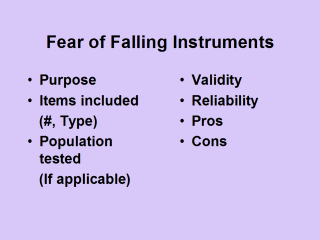| front |1 |2 |3 |4 |5 |6 |7 |8 |9 |10 |11 |12 |13 |14 |15 |16 |17 |18 |19 |20 |21 |review |
 |
We will be looking
at different fear of falling instruments and comparing them according to
several factors. First we値l consider the purpose of the instrument--why the instrument was created. We値l look at the number of items included and the type of items. A greater number of items could either be useful in providing more information or may be a burden on the client. The type of items are also important to consider. Some activities are more hazardous to perform than others. Depending on the functional level of the client, clinicians may want to choose instruments geared towards lower functioning or higher functioning seniors. The population that the instrument was tested on will also be helpful in determining the appropriateness of the tool for a particular client. If no validity and reliability testing was done, there will be no population mentioned. We値l mention whether validity and/or reliability tests have been conducted. I値l define a few terms in the next overhead to describe how this was done to ease interpretation of the table. However, we will not dwell on the psychometric properties of the instruments. Finally, we値l look at the pros and cons of each instrument. |